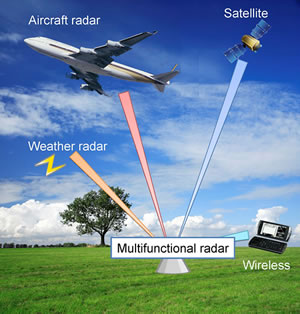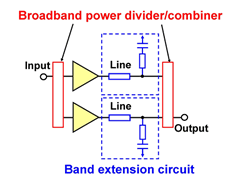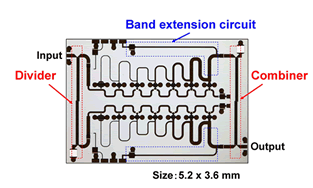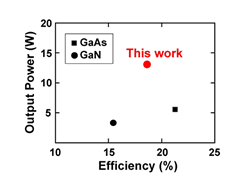Archived content
NOTE: this is an archived page and the content is likely to be out of date.
Fujitsu Develops Gallium-Nitride HEMT Amplifier Featuring World's Highest Output in the C-Ku Band
Realizes smaller, lighter radar and communications equipment
Fujitsu Laboratories Ltd.
-
[1] Gallium-nitride (GaN):
GaN-based semiconductors are wide bandgap semiconductors that feature a higher breakdown-voltage (threshold) than conventional semiconductor materials, such as silicon (Si) or gallium-arsenide (GaAs).
-
[2] High-electron mobility transistor (HEMT):
A field-effect transistor that utilizes the electron movement at the junction between two semiconductors with different band gaps - the electronic movement in HEMTs is faster compared to that of conventional semiconductors. Fujitsu led the industry with its development of HEMT technology in 1980, and HEMTs are currently used in a wide range of core technologies for IT applications, including satellite transceivers, mobile phones, GPS-based navigations systems, and broadband wireless networking systems.
-
[3] C-band, X-band, Ku-band:
Common names for each frequency band. The C-band covers 4GHz-8GHz and is not prone to attenuation from rain or fog. Applications employing C-band include satellite communications, fixed wireless networking, wireless access networking, air-traffic control radar, weather radar, etc. The X-band covers 8GHz -12GHz, and has only minimal impact from crosstalk and interference, thereby making the X-band difficult to be intercepted or jammed. The X-band is often used in satellite communications, air-traffic control radar, and weather radar. The Ku-band covers 12GHz-18GHz, and has only minimal impact from crosstalk and interference, thus making the Ku-band difficult to be intercepted or jammed. Ku-band applications include satellite communications and various types of radar.
-
[4] 18% efficiency:
Efficiency refers to the ratio of the high-frequency (h.f.) output power to the DC input power, taking into account the power amplifier gain.It is calculated as: Efficiency = 100*(h.f. output power – h.f. input power/(DC input power)
About Fujitsu Laboratories
Founded in 1968 as a wholly owned subsidiary of Fujitsu Limited, Fujitsu Laboratories Limited is one of the premier research centers in the world. With a global network of laboratories in Japan, China, the United States and Europe, the organization conducts a wide range of basic and applied research in the areas of Next-generation Services, Computer Servers, Networks, Electronic Devices and Advanced Materials. For more information, please see: http://jp.fujitsu.com/labs/en.
Technical Contacts
Advanced Devices Research Lab.Platform Technologies Lab.
![]() Phone: +81(46)250-8229
Phone: +81(46)250-8229
![]() E-mail: gan-hemt-press@ml.labs.fujitsu.com
E-mail: gan-hemt-press@ml.labs.fujitsu.com
Company:Fujitsu Laboratories Ltd.
Company and product names mentioned herein are trademarks or registered trademarks of their respective owners. Information provided in this press release is accurate at time of publication and is subject to change without advance notice.
Date: 27 May, 2010
City: Kawasaki, Japan
Company:
Fujitsu Laboratories Ltd.,
,
,
,
,



